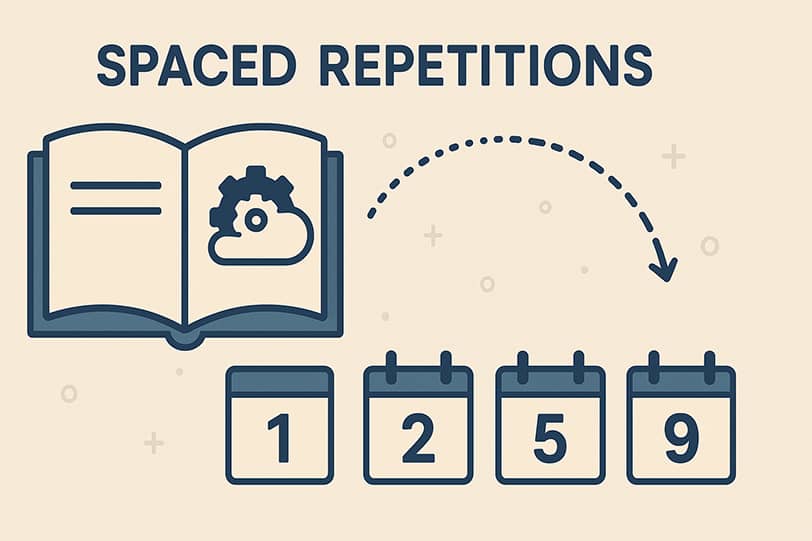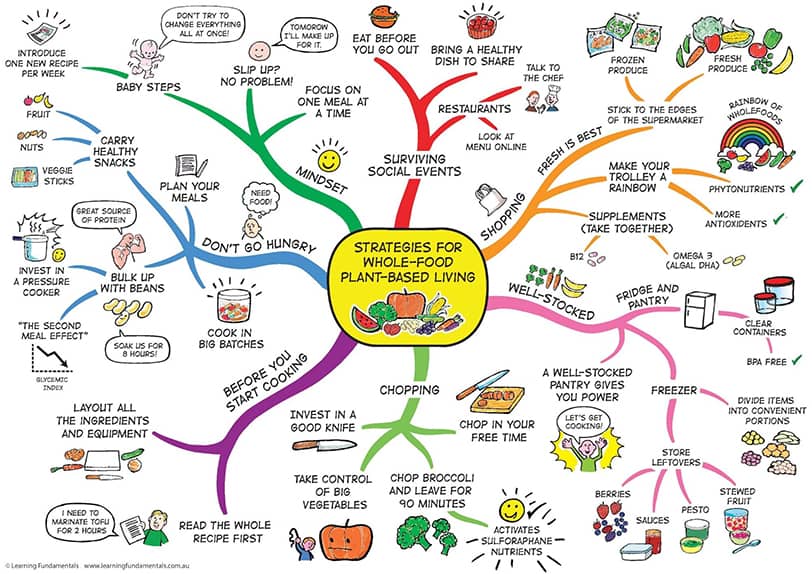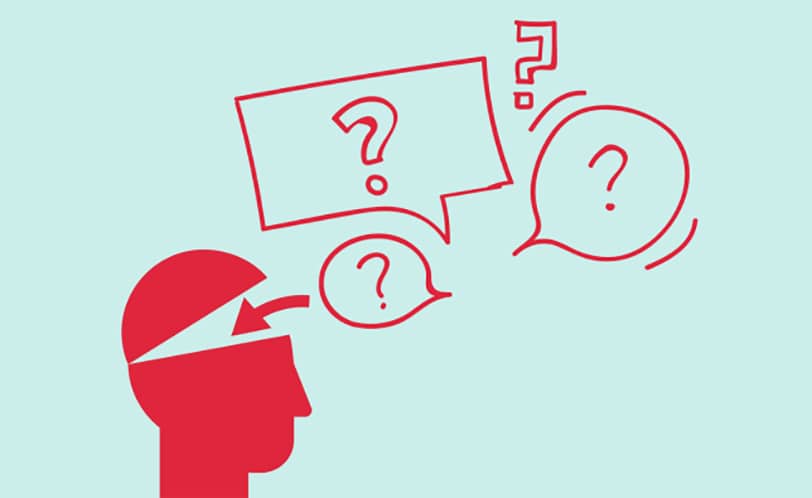Imagine you need to learn a complex topic for an exam. The first thing that comes to mind is to start cramming: repeating the material over and over until it’s “imprinted” in your memory. But after just a couple of days, you realize with horror that you’ve forgotten almost everything. What’s the problem? Traditional cramming relies on rote memorization—superficial learning without understanding the essence. The brain perceives such information as temporary and quickly discards it because it isn’t connected to existing knowledge or applied in practice.
Deep understanding works much more effectively—when you don’t just memorize facts but grasp the logic, connections, and can explain the topic in your own words. For example, if you understand how electric current works at the level of principles, not just memorized formulas, you’ll be able to solve even non-standard problems. That’s why the best learning techniques focus not on memorization but on comprehension: they help “embed” new information into your existing knowledge system, making it truly yours.
In this article, I’ll break down several such methods. The main one is the Feynman Technique, which teaches you to explain complex things simply. It’s complemented by spaced repetition (to avoid forgetting what you’ve learned), visualization (to engage imaginative thinking), and other psychological tricks. These aren’t just theories—they’re proven methods used by scientists, programmers, and polyglots. And the best part: they don’t require endless hours of textbook grinding, just the right approach. Let’s figure out how to learn faster and more meaningfully—without tedious cramming.

The Feynman Technique: Learn by Explaining
Imagine you need to understand a complex topic—say, quantum physics or macroeconomics. You read a textbook but feel like the information “goes in one ear and out the other”: it seems clear while the book is open, but as soon as you close it, only a vague memory remains. Sound familiar?
Nobel laureate Richard Feynman devised a method to solve this problem. Its essence is simple: if you can’t explain a topic in a way even a child could understand, you don’t truly understand it yourself. This approach not only helps you absorb information more deeply but also makes learning engaging—because instead of boring memorization, you become an explorer searching for the simplest, clearest explanations.
Who was Richard Feynman, and why does his method work?
Richard Feynman was a legendary physicist, famous not only for his scientific discoveries but also for his unique talent for explaining complex ideas clearly. He believed that the true test of knowledge is the ability to convey it to someone else without distortion.
Why is his method so effective?
- Combats the illusion of competence. We often think we “know” a topic until we try to explain it.
- Activates deep processing. Putting ideas into your own words builds new neural connections.
- Reveals gaps. Struggling to explain simply shows which areas need more work.
4 Steps of the Feynman Technique
- Choose a topic and study it. Don’t try to cover everything at once. Pick a specific question—e.g., “How does photosynthesis work?” or “What is inflation?” Study the material from textbooks, articles, or lectures, but don’t obsess over details—you just need the big picture.
- Explain it in simple terms (as if to a child). Imagine explaining the topic to a 10-year-old or a friend who knows nothing about it. Avoid jargon like “quantum superposition”—use everyday analogies instead. For example, compare electric current to water flowing through pipes.
- Identify gaps and revisit the material. If you stumble or realize your explanation is confusing, that’s a sign your understanding is shallow. Go back to your sources and clarify until you can describe the tricky part clearly.
- Simplify and use analogies. The perfect explanation is when your listener (or imaginary audience) says, “Now I get it!” To achieve this:
- Replace terms with everyday examples (“DNA is like an instruction manual for building an organism”).
- Sketch diagrams by hand.
- Connect new ideas to what’s already familiar (“Gravity is like a stretched blanket with planets as marbles”).
Example Application
Suppose you’re learning Ohm’s Law. Here’s how the Feynman Technique applies:
- Study: Voltage (V) = Current (I) × Resistance (R).
- Explain: “Imagine a water hose. Voltage is the water pressure, current is how much flows, and resistance is how tightly the hose is squeezed. If you squeeze harder (increase R), less water flows (I decreases) unless you raise the pressure (V).”
- Check: If you forget what affects current, return to the formula.
- Simplify: “Ohm’s Law is the rule for how current ‘responds’ to voltage and resistance.”
Why It Works
- Active recall. Saying things out loud forces your brain to retrieve information, not just passively absorb it.
- Pinpoints weak spots. Gaps become obvious when you can’t give a clear answer.
- The teaching effect. Research shows those who explain material retain 90% more than those who just read.
The Feynman Technique isn’t a “magic pill”—it’s a workout for your thinking. The more you use it, the easier it becomes to grasp even the toughest topics. Try it now: pick any concept and explain it to an imaginary child. If it doesn’t click right away, that’s fine—it’s all part of reaching real understanding.

Spaced Repetition
Have you ever noticed how quickly you forget material after cramming for an exam? A week later, only fragments remain. This isn’t your fault—it’s how our brains work. But what if there were a way to “trick” forgetting and retain information for years?
Spaced repetition is a scientifically backed learning method that aligns with the natural rhythms of memory. Unlike traditional cramming (where you repeat information in quick succession), this technique schedules reviews at specific intervals—just as you’re about to forget. It’s like memory training: you give your brain just enough effort to solidify knowledge without overloading it with useless repetition.
How the Brain Forgets Information (The Ebbinghaus Curve)?
In the late 19th century, German psychologist Hermann Ebbinghaus conducted experiments on his own memory. He memorized nonsense syllables (like “BEV” or “MUK”) and tracked how quickly they faded. The results became the “forgetting curve”, which shows:
- Within 20 minutes, ~40% of information is lost.
- After 1 hour, only 50% remains.
- After a week, just 20% stays.
- After a month, no more than 20%.
But Ebbinghaus also discovered a key insight: timely reviews dramatically slow forgetting. Each repetition “compresses” the information into long-term memory, flattening the curve.
How It Works: Reviewing at Optimal Times
The secret lies in strategically spaced intervals. The ideal moment to review is just before you’re about to forget—when retrieval requires slight effort but is still possible.
A typical review schedule looks like this:
- First review: 1 day after learning.
- Second review: 3 days later.
- Third review: 1 week later.
- Fourth review: 2 weeks later.
- Fifth review: 1 month later.
… and so on, gradually expanding the gaps.
These aren’t rigid rules but guidelines. Modern apps (like Anki) use algorithms to adjust intervals based on your personal forgetting speed.
Tools: Anki, Quizlet, and Flashcards
No fancy equipment is needed—you can start with paper flashcards. But digital tools streamline the process:
Anki:
- Free (available on all platforms).
- Uses a “smart” spaced repetition algorithm.
- Supports images, audio, and premade card decks.
- More user-friendly interface.
- Gamified learning modes.
- Collaboration features and a vast library of shared flashcards.
Paper Flashcards:
- Write a question/term on one side, the answer on the other.
- Sort into piles: “Know well,” “Know moderately,” “Don’t know.”
- Review each pile at different frequencies.
How to Apply It?
a) Schedule Reviews
- Create flashcards right after learning new material.
- First review: Next day.
- If correct, delay the next review (e.g., 3 days → 1 week → 2 weeks).
- If incorrect, move the card to the “soonest review” pile.
b) Active recall instead of passive reading
The golden rule: Don’t just reread—retrieve. Try:
- Covering the answer and recalling it aloud.
- Writing key points from memory.
- Explaining the material to an imaginary listener.
Studies show active recall is 2–3x more effective than passive review. Struggling to retrieve information strengthens neural connections far better than skimming notes.
Pro Tip: Don’t try to memorize everything at once. Spaced repetition works best with small, consistent sessions. Even 10–15 minutes daily with flashcards yields noticeable results within weeks.
Try this method with any subject. In a month, you’ll be amazed at how much sticks—without exhausting cramming or exam stress.

Visualization and Mind Maps
Text, tables, and lists are traditional note-taking methods that often prove ineffective. Why? Our brains process visual information 60,000 times faster than text, and images are remembered 65% better than words. These aren’t just impressive stats—they reflect how our memory evolved.
Mind mapping transforms dull notes into vibrant, colorful diagrams where every idea is visually connected. This isn’t just a “fun” technique for creative people—serious research confirms: students who use mind maps retain 32% more information and find needed data twice as fast in their notes.
Why Does the Brain Remember Images Better Than Text?
Our brains are wired so that:
- Visuals activate more neurons than text (engaging not just the language center but also the visual cortex).
- Colors and shapes create additional memory “anchors” (think how easily you recognize a company logo even if you forget its slogan).
- Spatial arrangement helps reconstruct the big picture (we literally “see” information in our mind’s eye).
- Associations act as natural memory “hooks” (an apple image can link to Newton, healthy eating, or Apple Inc.).
Neuroscientists explain this by noting that human visual systems evolved over millions of years, while reading text is a skill only a few millennia old. That’s why even complex concepts (like cell biology or economic cycles) are easier to grasp through diagrams than paragraphs.
How to Create Mind Maps?
1. Central Idea
- Take a blank sheet (preferably horizontal).
- Write/draw the main topic in the center (e.g., “World War II”).
- Use bright colors and large fonts.
2. Main Branches
- Draw curved lines from the center (straight lines are harder to remember).
- Label each with a key category: “Causes,” “Participants,” “Stages,” “Outcomes.”
- Use different colors for different branches (color-coding improves recall by 40%).
3. Sub-Branches
- From each main branch, draw thinner lines.
- Example: From “Participants” → “Allies,” “Axis Powers.”
- Use keywords, not sentences (“Stalingrad” instead of “The Battle of Stalingrad was a turning point”).
4. Images and Symbols
- Sketch simple icons (flags for countries, crossed swords for battles).
- Add arrows to show connections.
- Highlight critical points with markers or exclamation marks.
Example: A history lecture note on the “1929 U.S. Economic Crisis” as a mind map
- Center: Dollar bill with “1929 Crisis” written on it.
- Main branches:
- “Causes” (?) → stock speculation, overproduction.
- “Effects” (💥) → unemployment, bankruptcies.
- “Solutions” (💡) → Roosevelt’s New Deal.
- Connections: Arrow from “speculation” to “bankruptcies” labeled “market crash.”
This one-page map contains all key info—and a month later, you’ll recall it far better than five pages of linear notes.
Additional Methods
Sketchnoting
- Combines handwritten notes with simple drawings.
- Key elements:
- Fonts: Vary size and weight for emphasis.
- Dividers: Clouds, frames, dotted lines.
- Pictograms: Arrows, faces, weather icons for tone.
- Example: A biology lecture summary with DNA sketches 🧬, cell diagrams.
Connection Diagrams
- For complex systems with multiple relationships.
- Types:
- Venn diagrams (overlapping circles).
- Timelines.
- Flowcharts (e.g., stages of lawmaking).
Pro Tip: Start simple—turn a textbook chapter or work project plan into a mind map. Your first attempts may feel rough, but after 3–4 tries, you’ll notice how much easier it is to retain and organize information.
For inspiration, check out works by Tony Buzan (the method’s creator) or apps like MindMeister. Remember: there are no “wrong” mind maps—only ones that work for you.

The Pareto Principle (80/20 Rule) in Learning: How to Achieve More with Less Effort
Imagine you need to prepare for an exam in a week. The textbook has 500 pages, and time is running out. Can you learn what’s truly important without wasting time on secondary details? Turns out, you can—if you apply the Pareto Principle. This remarkable law states: 20% of your efforts yield 80% of the results, while the remaining 80% of work contributes only 20% of the outcome.
In learning, this works especially well. Just 20% of the right topics, exercises, or vocabulary can deliver 80% of your progress. This doesn’t mean the rest is useless—but you should start with what matters most. For example:
- Knowing just 300 most common English words lets you understand 65% of written texts.
- Mastering 20% of key physics formulas helps solve 80% of exam problems.
Let’s break down how to use this principle in studying.
The Rule: 20% Effort = 80% Results
Italian economist Vilfredo Pareto observed in 1897 that 20% of the population owned 80% of the wealth. Later, this pattern appeared everywhere:
- Business: 20% of customers generate 80% of profits.
- Programming: 20% of code handles 80% of functions.
- Education: 20% of material covers 80% of exam content.
Why does this work for learning?
- The brain retains frequently repeated information better.
- Core concepts unlock understanding of advanced topics.
- Focusing on essentials prevents attention fragmentation.
Note: This isn’t exact math but a guideline. Your ratio might be 30/70 or 15/85—the key is the uneven distribution of results.
How to Identify Key Topics and Focus on Them?
Step 1: Analyze the “High-Impact Zone”
- Scan the syllabus/textbook table of contents.
- Highlight topics that:
- Appear most often in exam questions.
- Serve as foundations for other sections.
- Contain key formulas/rules/definitions.
- Mark these—they’re your 20%.
Step 2: Prioritize by “Weight”
Example for a microeconomics course:
- Supply/demand curves (basis for 60% of problems).
- Elasticity theory (25% of questions).
- Market structures (10%).
- History of economic thought (5%).
Step 3: Consult Experts
- Ask instructors: “Which topics are most critical?”
- Check exam scoring systems for weight distribution.
- Review past exams for “golden” recurring questions.
Step 4: Create a Focused Plan
- 70% of time → Master the key 20%.
- 20% of time → Related secondary topics.
- 10% of time → Everything else (if time allows).
Example: Language Learning (Core Words & Grammar)
Applying the 80/20 rule to English:
1. Vocabulary:
- 300 most frequent words = 65% comprehension.
- Top 1,000 words = 85% of daily communication.
- Start with: articles, pronouns, core verbs (be, have, do).
2. Grammar:
- Present/Past/Future Simple (cover 80% of everyday use).
- Modal verbs (can, must, should).
- Sentence structure rules.
3. Practice:
- 20% of exercises: Writing original sentences.
- 80% of time: Listening/reading real dialogues.
1-Month Action Plan:
- Learn 300 words (10/day) → Use Oxford 3000 lists.
- Master 5 basic tenses (1 per week).
- Daily beginner podcasts (20 mins).
- Spend 80% of study time on real phrases, not rules.
Result: In 2–3 months, you’ll:
- Understand simple texts/conversations.
- Communicate while traveling.
- Build a foundation for advanced learning.
Key Nuance: The Pareto Principle isn’t an excuse for laziness. After mastering the first 20%, the next 20% (20→40%) might only give ~15% more results. But for serious progress, you’ll eventually need to cover those too. Start with what’s critical!
Try it now: Open your textbook or syllabus and highlight the top 20% of material. Focus on it this week – you’ll be amazed how much faster learning becomes.

Active Learning Through Practice
Have you ever noticed how easily you forget information you simply read? Now recall a skill you learned through practice—like driving or cooking a complex dish. Chances are, you still remember it. That’s the essence of active learning: knowledge sticks 10 times better when you apply it rather than passively consume it.
Neuroscience research shows that when we solve problems or explain concepts to others, our brains form stronger neural connections. It’s like the difference between watching a swimming tutorial and actually jumping into the water. The first lets you imagine the motions; the second forces your body and brain to work together, creating lasting skills.
Why Problem-Solving Beats Passive Reading?
The brain retains information best when it:
- Requires active effort (solving, analyzing, creating).
- Ties to real experience (emotions and movement boost memory).
- Repeats in varied contexts (solving 5 different problems > repeating 1 rule 5 times).
3 Key Benefits of Practice:
- Reveals gaps: Reading feels easy until you try solving problems—then weaknesses glare.
- Deepens understanding: Theory is a map; practice is the terrain. You only master a topic by “walking” it.
- Locks into long-term memory: Active tasks create 3x more neural connections than passive reading.
Active Learning Methods
a) Solve Problems Immediately After Theory
How to apply:
- Learn a new formula/rule → tackle 3–5 related problems.
- First problem: Use hints (follow a solved example).
- Second: Partial help (only the starting steps).
- Third onward: Solve independently.
Math example:
- Topic: Quadratic equations.
- Study the discriminant formula.
- Solve an equation alongside the textbook.
- Solve a similar equation solo (with different coefficients).
b) Learn by Teaching (Explain to a Friend)
Why it works:
- Forces you to structure knowledge.
- Exposes logical gaps.
- Boosts retention by 90% (the protégé effect).
How to do it right:
- Pick a “student” (real or imaginary).
- Prep like a real lesson (outlines, examples).
- Explain in simple terms (no jargon).
- Answer “dumb” questions—they test true understanding.
History example:
Try explaining WWI causes to a friend as if they know nothing. If you can avoid words like “annexation” and use everyday analogies instead—you truly grasp it.
c) Simulations & Case Studies
Best for:
- Medicine: Analyzing real patient histories.
- Programming: Writing code for specific tasks.
- Business: Solving real company case studies.
How to use:
- Find a real-world scenario (medical chart, buggy code, business crisis).
- Analyze it using new knowledge.
- Propose a solution.
- Compare your approach to experts’.
Medical example:
Instead of memorizing symptoms, work with a “patient card”:
- Symptoms: Dizziness, nausea.
- History: Hypertension.
- Task: Diagnose and order tests.
The Golden Rule:
The closer practice mimics reality, the better.
- Learning a language? Speak, don’t just drill exercises.
- Mastering Photoshop? Edit real photos, don’t just watch tutorials.
Try it today: After reading this, immediately solve 2–3 problems or explain the material aloud. You’ll feel the difference—knowledge becomes yours, not just textbook lines.

Mindful Breaks and Sleep: The Secret to Productive Learning
We often imagine effective learning as a marathon – the longer you sit with textbooks, the better the results. But our brain isn’t a processor that can work nonstop. It’s more like a muscle: after intense exercise, it needs rest to grow stronger.
Neuroscientific research shows that mindful breaks and quality sleep don’t just help us “reboot” – they directly impact information retention and comprehension. For example, short pauses during study sessions can boost productivity by 30%, while proper sleep transforms fragmented knowledge into solid neural connections.
The Zeigarnik Effect: Why Unfinished Tasks Get Remembered
In 1927, psychologist Bluma Zeigarnik conducted an experiment where participants received a series of tasks, some of which were interrupted before completion. It turned out people remembered interrupted tasks twice as well as completed ones.
How this works for learning:
- The brain better retains unfinished tasks in working memory
- This creates useful “cognitive tension” – a desire to return and figure things out
- The technique is especially effective for complex topics requiring deep understanding
How to apply it:
- Interrupt your study session at the most interesting point
- Leave your notes or problems incomplete – this keeps your brain subconsciously processing the material
- Return to the material after a break – retention will be deeper
The Pomodoro Technique: How Short Breaks Improve Memory
The pomodoro technique (from Italian “tomato”) isn’t just a work timer. Its effectiveness is confirmed by cognitive psychology research: alternating between focus and rest helps the brain better absorb information.
How it works:
- 25 minutes of deep concentration on one task
- 5 minutes of complete rest (no phones or new information!)
- After 4 cycles – a longer break (15-30 minutes)
Why this improves retention:
- Short intervals match the brain’s natural attention cycles
- Breaks allow time for “unconscious processing” of material
- Micro-breaks prevent fatigue and loss of motivation
Tips for maximum effect:
- During breaks: walk around, do light stretches, or just sit with your eyes closed
- Don’t check social media – it creates new cognitive load
- If you’re in the flow, you can extend to 50-minute sessions with 10-minute breaks
Sleep’s Role in Memory Consolidation
Sleep isn’t just “downtime” for rest. During sleep, the brain actively:
- Sorts information received during the day
- Transfers it from short-term to long-term memory
- Finds non-obvious connections between facts
What happens during sleep:
- Slow-wave sleep (deep): repetition and consolidation of facts, numbers, formulas
- REM sleep: processing of complex concepts and skills (languages, playing instruments)
- Memory “cleaning”: the brain removes unnecessary information, making space for what’s important
How to use sleep for learning:
- 1-2 hours before bed: review key points – the brain will process them overnight
- After learning something challenging: sleep within 3 hours – this is the optimal window for retention
- When acquiring new skills: 7-9 hours of sleep is more important than extra practice hours
Harvard research showed that students who slept after studying remembered the material 20-40% better than those who stayed awake.
How to Combine These Methods?
- Study in Pomodoro blocks, stopping mid-topic (Zeigarnik effect)
- During breaks: physical activity, no screens
- Review difficult concepts before sleep
- Get at least 7 hours of sleep – this makes your study efforts more effective
Try this today: when you sit down to study, set a timer for 25 minutes, and when it rings, get up and look out the window for 5 minutes. You’ll be surprised how much fresher your mind feels when you return to the material.
True productivity isn’t measured by hours spent with textbooks, but by smart distribution between focus, rest, and sleep.

Conclusion
When you understand the logic of material rather than just memorizing facts, knowledge becomes part of you – you can use it anytime, combine it, apply it to non-standard situations. It’s the difference between memorizing a route and learning to read a map – in the first case you risk getting lost at the slightest deviation, while in the second you can find your way in any conditions.
But how to make all these methods – the Feynman technique, spaced repetition, mind maps, the Pareto principle, active learning and mindful breaks – work together? The secret is personalization and gradual implementation. For example, you could start by explaining complex topics in simple terms (Feynman technique) and add short Pomodoro study sessions. Or combine spaced repetition with visualization by creating vivid flashcards with associations. The key is not to try everything at once, but to find 1-2 techniques that best suit your learning style and make them habits.
The simplest way to start:
- Try explaining something you’re currently learning to someone (even an imaginary listener) in simple terms
- Create a mind map for the next textbook chapter instead of regular notes
- Break your study time into 25-minute chunks with breaks
Don’t aim for perfect results immediately – the brain prefers gradual change. Even small adjustments to your study approach will eventually reveal all the benefits of learning without cramming.




